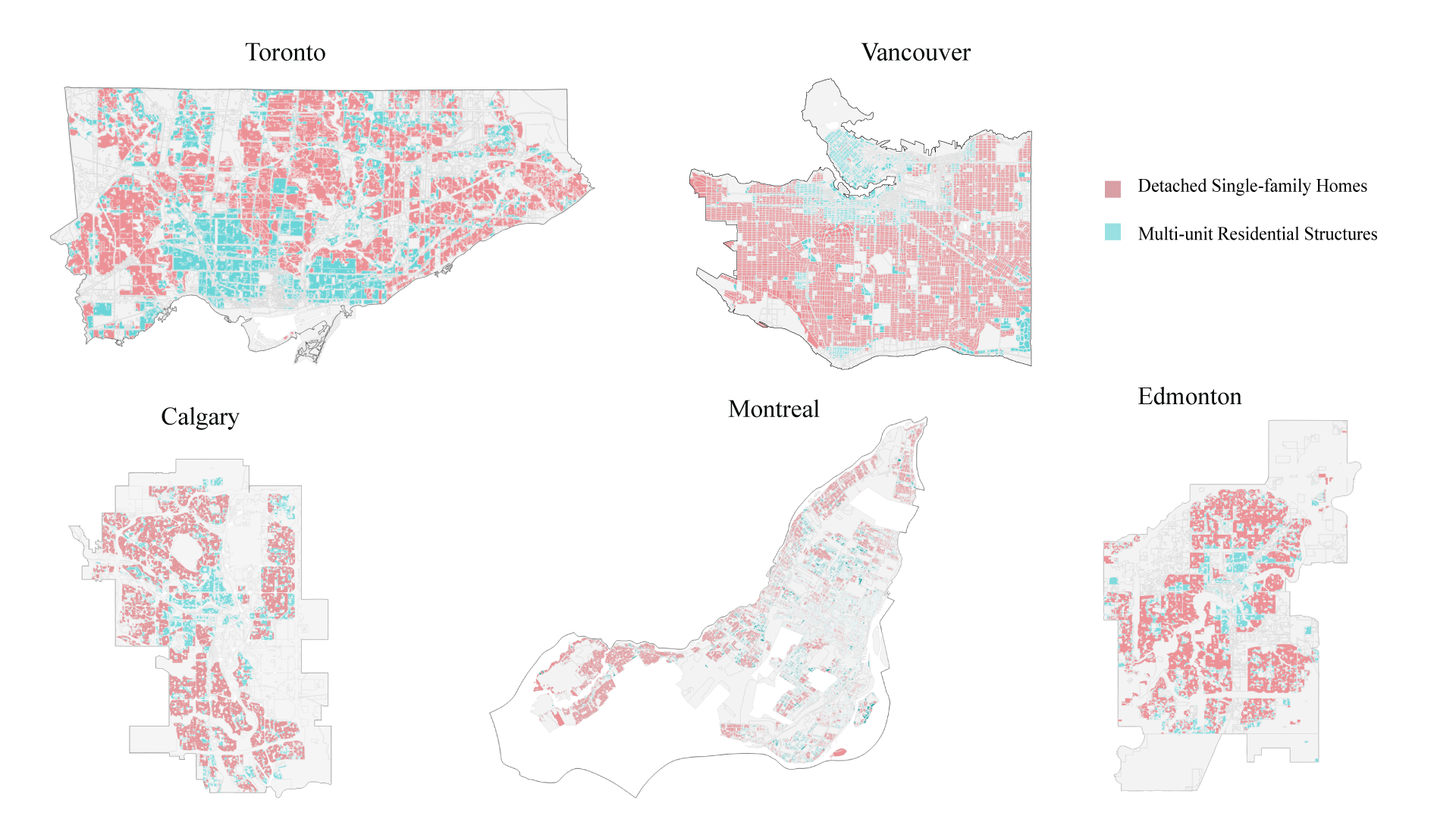
There is a contradiction going on in North America: people still fantasize owning a detached house with a garage and a yard a symbol of success, while urban areas are struggling to house a growing number of residents.
To make cities more affordable and accessible, many government officials and urban planners have started rethinking the detached-home-only zones. Minneapolis ended single-family zoning in the whole city last year. The state of Oregon recently terminated single-family zoning in all municipalities, the most radical measures in the U.S.
The New York Times’ data journalism column The Upshot quantified and visualized the single-family zonings in 10 US cities, to shed some lights on how zoning impact housing in the cities. This project is my equivalent attempt on Canadian cities.
The moves from our southern neighbor have incited a similar discussion in Canada. The New York Time’s insightful article with eye-appealing maps was also mentioned by Canada’s news outlets. Columnists suggested city officials in Canada should generate the same maps to indicate the single-family zoning in all major cities in the country.
Actually, the public and newsrooms do not need to rely on the government to do this job. Journalists with the right tools can complete this project since most municipalities have published zoning or land use data. Therefore, I built this visual guide to locate detached single-family zones in 5 Canadian cities.
Toronto

In Toronto, the Yellow Belt refers to the zoning areas that only allow detached or semi-detached houses. However, except a few lots, the majority land on the Yellow Belt only permits single-family houses. Such a zoning area ban any moderately higher density development, meaning that doors are closed to people and families who couldn’t afford a multi-million dollars of homes to enter these areas.
The public has mixed opinions on detached-houses zoning. The opponents accused it one cause of Toronto’s skyrocketing real estate prices and advocate for diverse types of houses permitted in these areas. The single-family homeowners, on the contrary, are concerned that densification would change the characters of the stable neighborhoods and therefore, devalue their properties.
Vancouver

The city perhaps has the most serious affordable housing crisis among all Canadian cities.
Although one-family dwelling zones take up over 80 per cent of residential land in Vancouver, the city does not exclude a secondary suite on a single-family house lot. Also, It is very common to see multiple households cohabitate inside a single-family house.
Nearly a decade ago the price of a detached house in Vancouver had already hit at least a million. Now a single-family house in Vancouver is twice the price of the median price in Canada. According to 2018 data, a Vancouver buyer needs a household income of $238,818 to qualify for a conventional mortgage on a detached home. Only 1 percent of the family in Vancouver can meet that end.
In fact, the city is going to decide on whether to abolish single-family zones this year.
Other Cities
Though housing is more affordable than those in Vancouver and Toronto, Calgary, Edmonton and Montreal have also discussed the zoning policies on detached single-family homes.

The Calgary city council last year voted to legalize secondary suites on single-dwelling zones, ended a year-long debate, despite many single-dwelling owners’ concern about parking shortages, overflowing garbage bins, and possibly more crimes.
The bylaw of Edmonton gives more options for a single-dwelling lot. A secondary suite or a garden suite can be built on the lot. A homeowner can even transfer his/her property to semi-detached or duplex if certain requirements are met. This change, made in December last year, basically terminated the detached-house only zone in Edmonton.
Since the early 2000s, the city of Montreal had planned for a more sustainable development model. The city has focused on building more low- and mid-rise apartments, instead of tall skyscrapers or single-detached homes. “More than three-quarters of the city’s residences are apartments in duplexes, rowhouses, semi-detached houses, or other buildings with fewer than five stories, more than double the 35 per cent figure for Canada as a whole.” Therefore, Montreal has the least amount of land covered by single-family houses among the five cities.
_____________________________________________________________________________________
Data sources: Toronto zoning bylaw shapefile: https://portal0.cf.opendata.inter.sandbox-toronto.ca/dataset/zoning-by-law/
Vancouver zoning bylaw shapefile: https://data.vancouver.ca/datacatalogue/zoning.htm
Montreal land use shapefile (2016): http://cmm.qc.ca/donnees-et-territoire/observatoire-grand-montreal/produits-cartographiques/donnees-georeferencees/
Calgary zoning bylaw shapefile: https://data.calgary.ca/Base-Maps/Land-Use-Polygons/gbpb-ymc5#revert
Edmonton zoning bylaw shapefile: https://data.edmonton.ca/Thematic-Features/City-of-Edmonton-Zoning-Bylaw-Map/b4f2-gf2b